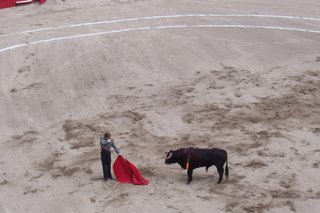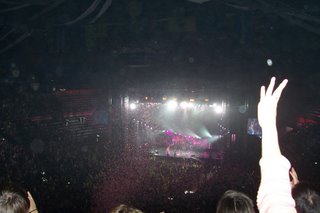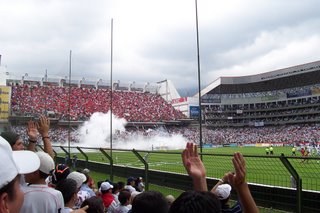Superstitions and...TEAR GAS!
This has been a rather calm week after the Quito fiesta-ing last week. I had to accustom myself once again to eight hours of daily Spanish class, and there was a lot of coffee involved (which I know is bad). Ecuadorians are big coffee lovers, and they often drink “esencia”, or “essence”, which is a reduced, extremely potent coffee syrup to which they add water or milk. I especially love the steamed milk varieties. They have all kinds of yummy drinks actually. I recently tried one called ponche, and it consists of a raw egg that is slowly cooked in boiling milk. It kind of tastes like egg nog. They also drink “morocho”, which really sticks to your ribs. It is made from corn flour and all kinds of interesting stuff. I have had a bit of a cold lately, so I decided to take the plunge and try one of the really scary tea concoctions on the street with my professor. I honestly felt like I was drinking some kind of green goop you would see on Double Dare (you know, the old T.V. show). The man first asked me what all of my symptoms were, and then he mixed all of these different kinds of liquids together (although I think he makes the same drink regardless of what the client describes). To this viscous mixture he added pollen seeds and other flaky things that scared me. Then he topped it off with aloe! I drank the whole thing and waited to die, but I was perfectly fine, if not even a bit better. They also have awesome fruit drinks here, and I really like “batidos” because they are made with milk and sugar. Yummmm. The fruit here is unreal. It is so fresh, and there are so many types that we simply don’t have in the U.S. Pitahaya, Maracuya, Babaco, and Granadilla are just a few examples of what the U.S. is missing out on.
I don’t think I’ve really touched on the highly superstitious nature of the people here, so I thought I’d share my experience on the bus today that I thought was impactful. I was sitting with my professor and I was admiring a really cute, chubby baby that was swaddled in a blanket. I kept staring at the baby and the baby caught my gaze and wouldn’t avert his eyes. His mother realized that he was looking at me and immediately covered his eyes. She then let me know in a not-so-subtle way that it was not okay to be looking at her baby. I was kind of taken aback, because usually people are complimented in the U.S. when you tell them that their baby is adorable. My professor told me that the reason she covered his eyes was to prevent my energy from entering her baby. Being that adults are older and stronger than babies, some people believe that adults can easily transfer their bad energy to babies. Many parents also put a red bracelet on their children’s wrists, because the color red is believed to ward off bad energy. I also noticed in some situations that people do not shake hands. I found this odd because people are typically very warm and welcoming here. I was told that negative energies can pass through the hand, and if a person is having a really good day, they hesitate to shake hands in fear that they will lose their good energy. Likewise, people do not want to receive potential negative energy, and they may not shake hands. Another interesting practice involves the famed guinea pig, or cuy. Sometimes people go to a shaman if they aren’t feeling well. The shaman will pass a live guinea pig over the entire body of the infirm, and then he will kill the guinea pig. He will then cut open the animal and observe all abnormalities with its organs. They say that the guinea pig instantly changes and absorbs the disease or problem of the sick person, and the shaman can find out what’s wrong with the patient by looking at the now sick guinea pig. I’m skeptical. Another superstition is not bathing after eating. I’m rather sure this derived from the common-held belief that swimming after eating is dangerous. I was not too surprised by this thought because the same thing happened in Costa Rica. My house mother, Juana, is always waiting for something fatal to happen when I shower after dinner, but I’ve survived unscathed so far, thank goodness. I can’t think of any more superstitions, but there are tons more.
The Christmas season is picking up here, and it’s been fun too see all of the nativities, lights, and trees. Ecuadorians celebrate Christmas much in the same way that Americans celebrate the holiday. Many people have never heard of Hanukkah though, which is funny. I was describing the dreidel game to a professor, and he told me that they play a similar game in Ecuador with a four-sided top. I looked into it a little more, and I soon realized that it is actually a derivative of the dreidel game. Exiled Jews from Spain brought the game here, which I think is really neat. It’s lost its religious significance today in Ecuador, but its roots are with the Spanish Jews centuries back. Many people here are dreading the holiday season because they don’t have anything to give to their families. The more fortunate also dislike seeing the sadness and poverty in the streets. I was told that many indigenous people come from their homes in the farms and fields to Quito to ask for charity. It has been interesting to see the shopping malls here and to observe the people who have the resources to shop in them. They compose such a small percentage of the population.
I also want to touch on an interesting conversation I had over dinner with my host family tonight. My roommate, Karin, is from Switzerland, and her Mexican friend, Sandra, flew in from Mexico D.F. last night. We all had dinner with Cesar and Juana (dad and mom), and we talked about stereotypical slang. Cesar asked me if I was offended when someone called me a gringa. It truly depends on the intent and tone of voice in my opinion because I’ve come to see that not everyone intends to offend when they use the word gringo. Nevertheless, the word still has negative connotations, and I’m not quite sure why. Ecuadorians use the word to describe all foreigners of lighter skin, not just North Americans. I’ve always thought that being called a gringo was an insult because it assumes that as Americans we are brutish, arrogant, insensitive, egotistical, and unaware of other nations. I’ve never really thought about it or asked fellow Americans about it though. My house father thinks it’s a synonym for foreigner, devoid of all negative connotation. Who knows? I’d like to hear your feedback about this if you get a chance. Are you or would you be offended to be called a gringo? What kinds of connotations does the term hold for you? (I’ve also observed how important it is not to say “American” to refer to someone living in the United States. NORTH American or Estadounidense is preferable because all South Americans are Americans technically as well).
Oh! I almost forgot to talk about my first experience with tear gas! Yikes! That stuff is horribly immobilizing. I was walking to the bus in my own little world last Friday when, all of a sudden, I noticed that everyone was walking away from the main street covering their mouths and wiping their eyes. How strange, I thought. I kept on walking (like a complete idiot), and then I saw a massive protest. Behind the mob were clouds of tear gas. I quickly realized that I probably needed to not be in the middle of a protest, so I jetted and ran. Tear gas is so fast-acting it’s amazing. It affects your throat more than it affects your eyes, in fact. I honestly felt like if I didn’t drink something my throat was literally going to fall out of my body. It comes to find out that college students all over Quito are protesting because the city bus drivers want to raise the rate from .25 cents to .35 cents. All of this rioting is over a mere ten cents, but when a Quiteño rides four buses daily, this increase can add up. Needless to say, the protests are still going on, but I’ve found a better way to get home tear gas free.
This is the week in review. I hope everyone who is still in university isn’t stressing too much over final exams. It sure is nice not to be in those shoes right now! For any and all who want a silly laugh, I’d recommend seeing “Happy Feet”. It’s a movie that combines a little Latino culture with penguin life…something we all could use.



